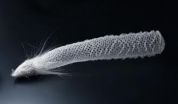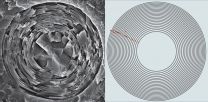(Press-News.org) PROVIDENCE, R.I. [Brown University] -- Life may seem precarious for the sea sponge known as Venus' flower basket. Tiny, hair-like appendages made essentially of glass are all that hold the creatures to their seafloor homes. But fear not for these creatures of the deep. Those tiny lifelines, called basalia spicules, are fine-tuned for strength, according to new research led by Brown University engineers.
In a paper published in the Proceedings of the National Academy of Sciences, the researchers show that the secret to spicules' strength lies in their remarkable internal structure. The spicules, each only 50 microns in diameter, are made of a silica (glass) core surrounded by 10 to 50 concentric cylinders of glass, each separated by an ultra-thin layer of an organic material. The walls of each cylinder gradually decrease in thickness moving from the core toward the outside edge of the spicule.
When Haneesh Kesari, assistant professor of engineering at Brown, first saw this structure, he wasn't sure what to make of it. But the pattern of decreasing thickness caught his eye.
"It was not at all clear to me what this pattern was for, but it looked like a figure from a math book," Kesari said. "It had such mathematical regularity to it that I thought it had to be for something useful and important to the animal."
The lives of these sponges depend on their ability to stay fixed to the sea floor. They sustain themselves by filtering nutrients out of the water, which they cannot do if they're being cast about with the flow. So it would make sense, Kesari thought, that natural selection may have molded the creatures' spicule anchors into models of strength -- and the thickness pattern could be a contributing factor.
"If it can't anchor, it can't survive," Kesari said. "So we thought this internal structure must be contributing to these spicules being a better anchor."
To find out, Kesari worked with graduate student Michael Monn to build a mathematical model of the spicules' structure. Among the model's assumptions was that the organic layers between the glass cylinders allowed the cylinders to slide against each other.
"We prepared a mechanical model of this system and asked the question: Of all possible ways the thicknesses of the layers can vary, how should they vary so that the spicule's anchoring ability is maximized?" Kesari said.
The model predicted that the structure's load capacity would be greatest when the layers decrease in thickness toward the outside, just as was initially observed in actual spicules. Kesari and Monn then worked with James Weaver and Joanna Aizenberg of Harvard's Wyss Institute for Biologically Inspired Engineering, who have worked with this sponge species for years. The team carefully compared the layer thicknesses predicted by the mechanics model to the actual layer thicknesses in more than a hundred spicule samples from sponges.
The work showed that the predictions made by the model matched very closely with the observed layer thicknesses in the samples. "It appears that the arrangement and thicknesses of these layers does indeed contribute to the spicules' strength, which helps make them better anchors," Kesari said.
The researchers say this is the first time to their knowledge that anyone has evaluated the mechanical advantage of this particular arrangement of layers. It could add to the list of useful engineered structures inspired by nature.
"In the engineered world, you see all kinds of instances where the external geometry of a structure is modified to enhance its specific strength -- I-beams are one example," Monn said. "But you don't see a huge effort focused toward the internal mechanical design of these structures."
This study, however, suggests that sponge spicules could provide a blueprint for load-bearing beams made stronger from the inside out.
INFORMATION:
The research was supported by grants from the National Science Foundation (DMR-0520651, DMR- 1420570) and the KIMM-Brown Nano and Micromechanics for Disaster Mitigation and Technological Reliability project.
ANN ARBOR, Mich. - What happens in the moments just before death is widely believed to be a slowdown of the body's systems as the heart stops beating and blood flow ends.
But a new laboratory study by the University of Michigan Medical School reveals a storm of brain activity that erupts as the heart deteriorates and plays a surprising destabilizing role in heart function.
This near-death brain signaling may be targeted to help cardiac arrest patients survive. Most of the more than 400,000 Americans who experience cardiac arrest at home, at work or in public die without ...
Researchers sketching out a wiring diagram for rat brains -- a field known as "connectomics" -- have discovered that its structure is organized like the Internet.
For years, scientists looking for clues to brain function through its structure focused on what could be seen -- the brain's lobes, grooves and folds. Now, with a more comprehensive picture of how neurons connect to one another, they've discovered local networks of neurons nested into one another like shells.
"The cerebral cortex is like a mini-Internet," said Larry Swanson, professor at the USC Dornsife College ...
Scientists funded by the National Institute of Allergy and Infectious Diseases (NIAID), part of the National Institutes of Health, have identified a cellular receptor for rhinovirus C, a cold-causing virus that is strongly associated with severe asthma attacks. A variant in the gene for this receptor previously had been linked to asthma in genetic studies, but the potential role of the receptor, called CDHR3, in asthma was unknown. The new findings help clarify the function of CDHR3 and point to a novel target for the development of prevention and treatment strategies against ...
Researchers are always searching for improved technologies, but the most efficient computer possible already exists. It can learn and adapt without needing to be programmed or updated. It has nearly limitless memory, is difficult to crash, and works at extremely fast speeds. It's not a Mac or a PC; it's the human brain. And scientists around the world want to mimic its abilities.
Both academic and industrial laboratories are working to develop computers that operate more like the human brain. Instead of operating like a conventional, digital system, these new devices ...
New mothers in the Philippines spend more time in the bedroom with their partner in the first few weeks after giving birth than they did before they became pregnant. This might be a type of survival strategy to keep the relationships with the fathers of their new babies alive and well, to ensure continued support for their offspring. So says Michelle Escasa-Dorne of the University of Colorado in the US, after studying how women from a society with a low divorce rate such as the Philippines adapt to being both mothers and lovers. The study appears in Springer's journal Human ...
WINSTON-SALEM, N.C. - April 6, 2015 - A commonly prescribed antidepressant caused up to a six-fold increase in atherosclerosis plaque in the coronary arteries of non-human primates, according to a study by researchers at Wake Forest Baptist Medical Center. Coronary artery atherosclerosis is the primary cause of heart attacks.
The study is published in the current online issue of the journal Psychosomatic Medicine.
"The medical community has known for years that depression is closely associated with heart disease, but we didn't know if treating it would reduce the heart ...
A new UCLA study takes another step toward the early understanding of a degenerative brain condition called chronic traumatic encephalopathy, or CTE, which affects athletes in contact sports who are exposed to repetitive brain injuries. Using a new imaging tool, researchers found a strikingly similar pattern of abnormal protein deposits in the brains of retired NFL players who suffered from concussions.
The innovative imaging technique uses a chemical marker combined with positron emission tomography, or PET scan, and was initially tested in five retired NFL players ...
SAN FRANCISCO--The Pacific and North America plate boundary off the coast of British Columbia and southeastern Alaska is a complex system of faults capable of producing very large earthquakes. The recent 2012 Mw 7.8 Haida Gwaii and 2013 Mw 7.5 Craig earthquakes released strain built up over years, but did not release strain along the Queen Charlotte Fault, which remains the likely source of a future large earthquake, according to reports published in a special issue of the Bulletin of the Seismological Society of America (BSSA).
"The study of these two quakes revealed ...
Massachusetts General Hospital (MGH) investigators have identified an inflammatory molecule that appears to play an essential role in the autoimmune disorder systemic lupus erythematosus, commonly known as lupus. In their report being published online in Nature Immunology, the researchers describe finding that a protein that regulates certain cells in the innate immune system - the body's first line of defense against infection - activates a molecular pathway known to be associated with lupus and that the protein's activity is required for the development of lupus symptoms ...
MIT researchers have developed a new, ultrasensitive magnetic-field detector that is 1,000 times more energy-efficient than its predecessors. It could lead to miniaturized, battery-powered devices for medical and materials imaging, contraband detection, and even geological exploration.
Magnetic-field detectors, or magnetometers, are already used for all those applications. But existing technologies have drawbacks: Some rely on gas-filled chambers; others work only in narrow frequency bands, limiting their utility.
Synthetic diamonds with nitrogen vacancies (NVs) -- ...


